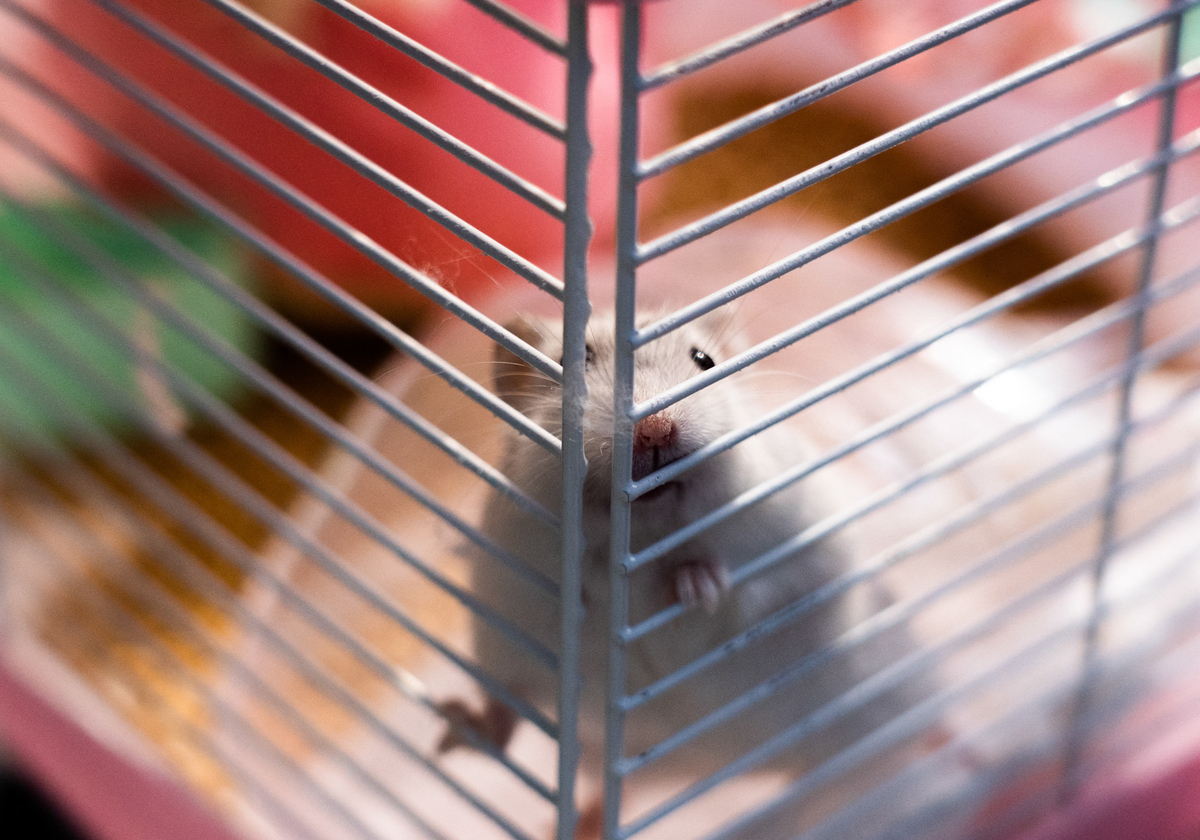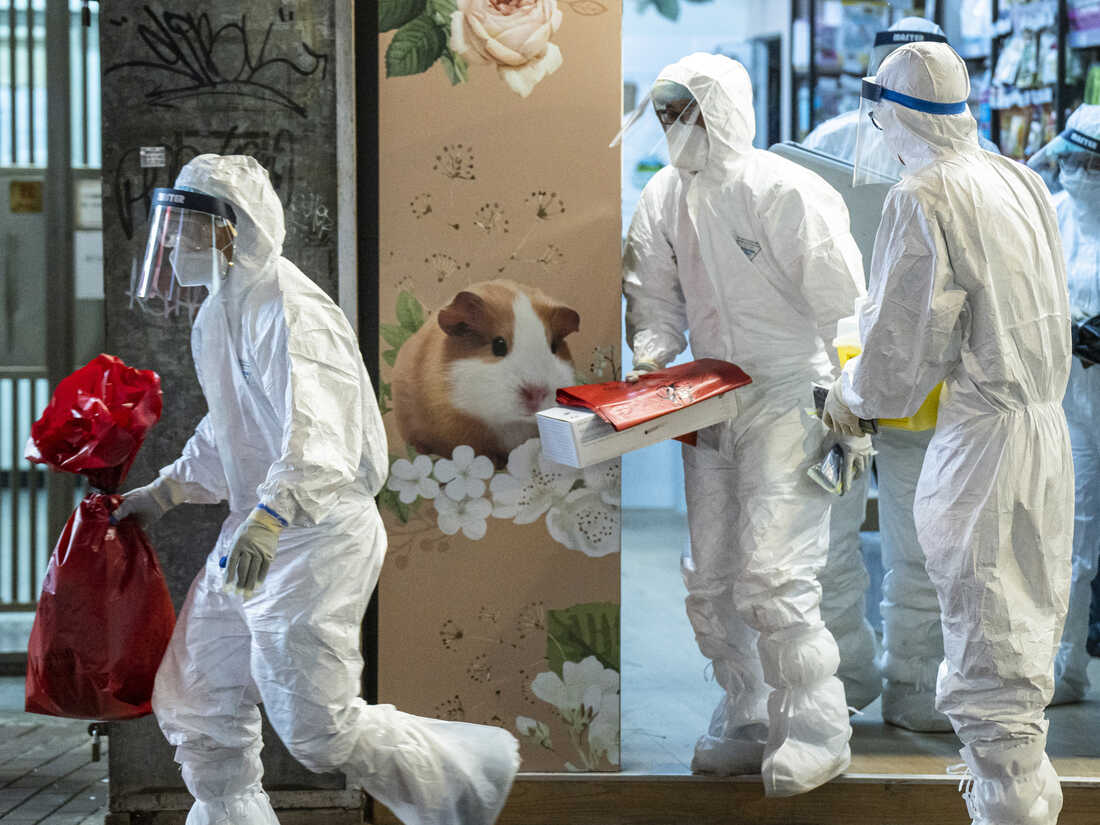
The hamsters of Hong Kong offer a cautionary COVID tale

A hamster named “Marshmallow” was dropped off at the New Territories South Animal Management Centre in Hong Kong on Jan. 19 over concerns that the pets were spreading COVID-19 to humans. Thousands of small animals were culled after hamsters tested positive in a pet store. Bertha Wang/AFP via Getty Images hide caption
toggle caption
Bertha Wang/AFP via Getty Images

A hamster named “Marshmallow” was dropped off at the New Territories South Animal Management Centre in Hong Kong on Jan. 19 over concerns that the pets were spreading COVID-19 to humans. Thousands of small animals were culled after hamsters tested positive in a pet store.
Bertha Wang/AFP via Getty Images
Hamsters can infect people with COVID which then goes on to spread among the human population – that’s the assertion in a new study about the events of mid-January when Hong Kong announced that at least three cases of COVID were linked to hamsters in a pet store.
The discovery was documented in a preprint study for the Lancet uploaded on Jan. 28 but not peer reviewed or published yet. The study adds to previous research showing SARS-CoV-2 transmission from minks to humans on farms in Denmark.
It’s not that surprising that animals can be infected by people, Leo Poon, professor of public health at the University of Hong Kong and one of the authors of the hamster study, tells NPR. But he was surprised to see the virus then spill back into people from a newly identified animal source and cause human-to-human transmission, he says.
“The possibility of animal-to-human transmission of SARS-CoV-2 is a major public health concern,” he wrote in an email. “We need to take serious effort to prevent this transmission and vice versa.”
The sequence of infection in Hong Kong began when a fully vaccinated pet store employee tested positive for COVID. Health officials were surprised because of the low case count for COVID in Hong Kong. And when they found out it was the delta variant, they were shocked: The only other cases in Hong Kong at the time were importations of the omicron variant, which had been identified in late November.
And there was something even stranger about this particular version of the delta variant. It had picked up a few mutations scientists had never seen before among delta cases in the city.
After the employee tested positive, public health workers turned to the animals in the pet store, taking viral swabs and blood samples in the store as well as its warehouse. More than half of the hamsters tested positive for SARS-CoV-2.
It came from the Netherlands
By examining the genetic fingerprint of the virus, they realized that some hamsters imported from the Netherlands had passed the virus to other hamsters and then at least two people – the employee and a customer who stopped by the store briefly. The customer then gave the virus to her husband, which means this mutated version of the delta variant was fit for human spread.
In experiments, the researchers note, hamsters most often gave the virus to other hamsters via airborne transmission or direct contact. Given the briefness of the customer’s visit, it’s possible airborne transmission happened in this case as well.
This variant has now spread to at least 50 other people in Hong Kong, according to reports.
The at-risk hamsters in Hong Kong, like the mink in Denmark, were culled – in all, about 2,000 hamsters sold between December 22 and January 19 were surrendered to officials for testing and euthanization.

Workers with Hong Kong’s Agriculture, Fisheries and Conservation Department remove small animals from a pet store in Hong Kong after hamsters tested positive for COVID-19. Chan Long Hei/Bloomberg via Getty Images hide caption
toggle caption
Chan Long Hei/Bloomberg via Getty Images

Workers with Hong Kong’s Agriculture, Fisheries and Conservation Department remove small animals from a pet store in Hong Kong after hamsters tested positive for COVID-19.
Chan Long Hei/Bloomberg via Getty Images
Trying to stop the spread
Decisions like these are complicated, and health officials make them based on their goals and policies around disease transmission, says Suresh Kuchipudi, clinical professor of virology at Penn State and co-author of studies on deer and SARS-CoV-2. But he doesn’t think culling all the animals that test positive, especially wildlife like deer, is possible.
There are other ways to stop the spread, he says, like deploying coronavirus vaccines for animals and isolating people who come into contact with animals that test positive.

The virus is also spreading through deer populations in the United States. A new preprint study from Kuchipudi and others uploaded on Feb. 7 shows the first-ever omicron infections in white-tailed deer on Staten Island.
So far, there is no evidence of deer-to-people transmission.
There have been plenty of cases of humans giving the virus to animals. COVID infections have also been found in animals like ferrets, cats, dogs, racoon dogs, fruit bats and deer mice as well as zoo animals like lions, tigers, pumas, gorillas and hyenas.
Those cases have only been discovered because we’ve looked at those animals, scientists say. The virus could be spreading among other animal populations that aren’t monitored as well or at all.
The hamster study points out that attention should be paid to spillback into humans, says Poon. “The possibility of animal-to-human transmission of SARS-CoV-2 is a major public health concern,” he wrote in an email. “We need to take serious effort to prevent this transmission and vice versa.”
Scientists worry the virus may mutate as it passes between animals and people, creating new variants that could partially or fully escape the protection offered by vaccines. And animals could serve as a reservoir of the virus, continuing to spread it even when cases among humans are more controlled.
One reason Hong Kong found the infected hamsters
Having so few COVID cases in Hong Kong, as well as excellent genomic surveillance of the virus, helped the researchers spot the hamster-human connection.
But in places like the U.S., where the virus is spreading in substantial numbers among people, “spillback events might be very difficult to be detected,” Poon says.
That means we’re probably under-counting animal transmission around the world, he adds.
In New York City, for instance, a strange version of the virus has appeared in sewage for the past year – making researchers suspect it could be circulating among rats or other animals. So far, no animal-to-human transmission of that variant has been found.
Animal COVID is worrisome but …
“We don’t really know the extent of the problem in deer, let alone other animals,” Kuchipudi says. “There is a huge gap in our understanding. Whatever might be happening in terms of virus evolution that is currently hidden from our sight could result in another variant.”
It’s possible the virus could spread from deer to cats or deer mice or other animals, and then back to humans, picking up mutations along the way, he says – there’s just not enough monitoring of animals to know if and how that is happening.
“Uncontrolled or unmonitored spread of the virus in animal reservoirs or multiple animal hosts could mean that the virus will continue to evolve, which results in the possibility of emergence of novel variants that could potentially undermine the protection provided by the current vaccines in humans completely,” Kuchipudi says.
One deer in the study already had antibodies from prior infection with SARS-CoV-2 and still tested positive for omicron – showing that breakthrough infections may happen in animals just as they do in people, he says.
That has troubling implications for the continued spread of the virus in animals and people, he says.
Having reservoirs of potentially evolving viruses can be problematic, Michael Worobey, the head of the ecology and evolutionary biology department at the University of Arizona, who didn’t work on the hamster or deer studies, tells NPR.
“It is potentially concerning that something could end up in something like whitetail deer and evolve for, let’s say, five or 10 years in that population, and then jump back into humans and have picked up a whole bunch of mutations that allow for escape from human immune responses, or some degree of escape,” he says.
But he remains most concerned about human-to-human spread of the coronavirus, especially when the virus has opportunities to evolve for months among people who are immune-compromised. When the virus evolves in people, it’s more likely to become better at making humans sick – mutations in hamsters or deer might not affect us as much.
“Let’s not get too wrapped up in worries about animals,” Worobey says, when each wave of COVID brings more opportunities for the virus to evolve in people.
Besides, stopping COVID surges among people would make it much less likely for animals to be infected, too.
Melody Schreiber (@m_scribe) is a journalist and the editor of What We Didn’t Expect: Personal Stories About Premature Birth.
Source: https://www.npr.org/sections/goatsandsoda/2022/02/10/1049308976/the-hamsters-of-hong-kong-offer-a-cautionary-covid-tale















